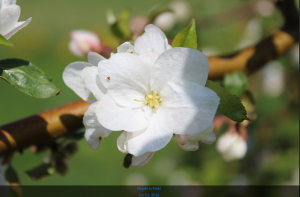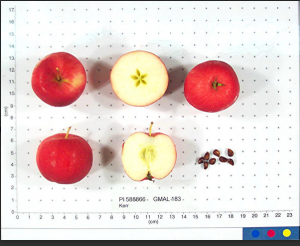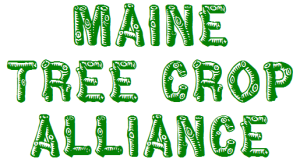A Casual Hobby With Fruitful Rewards
—by Jack Kertesz & Laura Sieger
Do you like:
- plants?
- intrigue?
- history?
- adventure?
Then you may want to join the ranks of amateur fruit explorers literally “beating the bushes” in pursuit of what’s out there.
DO I NEED A BACKGROUND IN BOTANY?
It could help—just keep it simple to start. It doesn’t take a highly trained eye to get familiar with WINTER identification of some plants. Nut trees in particular seem to stand out once you’ve learned a few of their characteristics. Pears mostly have an upright stature that you can learn to easily recognize. Apples are so pervasive in some places that you can quickly “imprint” on them. Plums also exhibit traits that add up. Spring bloom time is an excellent way to discover plants from a drive-by mode. Learn the bloom sequence: apricots and plums start the season off; cherries, pears and apples soon will all add their “snow” to the show.
WHAT TOOLS DO I NEED?
Not much. A knife is handy to cut into fruit in the Fall. A notebook, pruners, labels, pen and a plastic bag for gathering scion wood the following Spring. A Fruit Explorer’s Data Collection card can be useful. To better report on fruit, a handy USDA sizing grid could be helpful. The photo at right shows an example photo taken of a found apple using the handy sizing grid. And if you’re exploring in the sporing, don’t forget to take a closeup photo of a blossom (see top image).
It’s helpful to have a little checklist of what to bring and record while fruit exploring. I try to write something about the location or an on the spot name on the bag or bushel I collect into. I also try to remember to take photos of the tree, the fruit, a landmark and whatever i wrote on the bag on my phone so that those are all there time/date stamped and GPS located. when i’m really on top of it I’ll mark the spot with hopefully a useful note or date in my gazetteer. I almost never remember to cut the fruit in half and take a photo. It’s helpful to use this grid from USDA to standardize photos of varieties we grow. It can be printed on cardstock on a regular 9.5×11 at the correct size. It’s not beautiful, but it gives a good reference to size, shape, color of the fruit. seed color, internal features, etc.
WHERE SHOULD I LOOK?
Start locally. Your backyard, back forty, or suburban neighborhood all have prospective material. Take a walk, take a hike, ride a bike. Celebrate serendipity—don’t ignore the chance encounter. Look around at the landscape next time you grind to a halt for a yard sale, visit friends, family or even the dentist! If you are exploring on other’s property, sometime an Introduction Card can help explain what you are doing.
WHAT SHOULDN’T I DO?
I have to admit having been a bit overzealous at times—startling a few people in my moments of reckless abandon. Respect Property. Ask First. Be Considerate. Make Friends, not Enemies.
WHO CAN I CONTACT TO GET STARTED?
Older folks familiar with the area may help if you’re interested in a particular fruit or what may have been grown in the area. Grange members and Historical Societies can also be approached for clues.
WHAT IF I FIND SOMETHING UNUSUAL?
John Bunker at FEDCO TREES (873-7333) is particularly interested in apples of Maine origin and is knowledgeable about a wide range of fruit. Please be aware that specific identification of varieties is rather difficult, especially since many fine unnamed wild apples may look and taste similar to known varieties. John has a wonderful book available from Fedco Trees about his apple searching adventures in Palermo, Maine.
CAN I GET SICK SAMPLING FRUIT?
I wouldn’t rule out this possibility. Animal manures and wildlife scat can easily contaminate drops. E. coli bacteria—some strains are lethal to some folks—at one time practically shut down the fresh cider industry. Fruit on the tree may carry bird droppings. More likely are run ins with some extremely astringent fruit…another good reason to carry along water. Then there’s always the temptation to sample lots of fruit—a harbinger of memorable bellyaches.
THINGS TO CONSIDER
I have had fun in the past with family and friends taking a moment to investigate some dangling tree treasure. There were frequent instances of instant disappointment and occasional triumphs. I enjoy the lure of the bounty, the “hunt” and the excitement of finding another fruit to share with others. It’s a richness to savor. I personally don’t search for heirlooms and consequently potential search areas are numerous.
THE ONE TIME TASTE TEST
To be fair, a certain number of fruit actually improve in flavor and palatability during storage. Cooking may also enhance fruit quality. Try saving some for future use.
ANECDOTAL CASES
I have found reasonably pest free apples growing in the wild that were likely planted by deer. Some were actually edible. More amazing to me were two choice finds in city environments… chance sprouts from grafted crabapples. (With neglect, root stock sprouts from the base of a crab can cohabit with the original specimen. Since seedling root stock material is often grown out from the cleaned pomace of commercial orchards, there is a possibility that these seedlings (or those that deer plant) will bear fruit of quality). One I “discovered” while taking a break from a tedious landscaping job and the other from a casual glance at an Interstate ramp planting. Both trees have since been cut down! The point here is to Be Open To Fruit Finds WHEREVER You Go.
This paper is part of a continuing effort of the MAINE TREE CROP ALLIANCE to help “Preserve the old but know the new.” Most notable for its Spring Scion Wood Exchange, there currently is no membership fee. To join, you simply JOIN IN .



